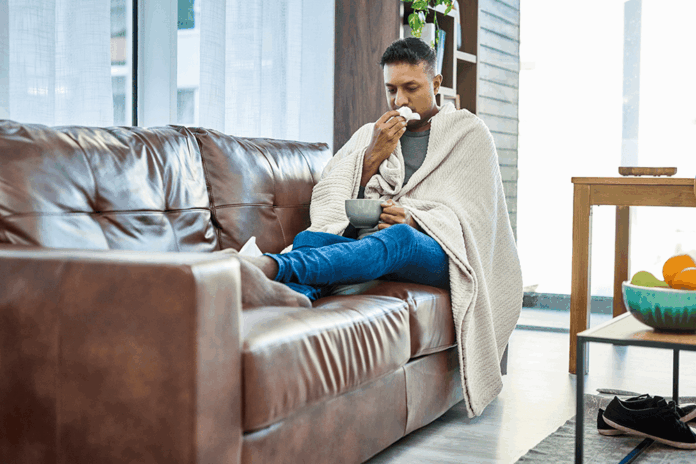By Donna Itzstein, Pharmacist & Credentialled Diabetes Educator
As the weather cools down and cold and flu season arrives, it’s a good time to ask: Do you have a sick day plan?
This is especially important when you live with diabetes. Even a common cold, gastro, or respiratory infection can affect your blood glucose levels (BGLs).
When you’re unwell, your body is under stress. Stress causes the release of hormones that push more glucose into your bloodstream. This is your body’s way of giving you energy to fight infection, but if you have diabetes, it can lead to high BGLs.
High BGLs can make you dehydrated and slow down your recovery.
Start following your plan if:
- You feel unwell or show signs of infection
OR - Your blood glucose levels are above 15 mmol/L for 6 to 12 hours or more
If you don’t already have a sick day plan, now’s the time to talk to your diabetes team about making one that suits your type of diabetes.
Sick day factsheet for people living with type 1 diabetes.
Sick day factsheet for people living with type 2 diabetes.
When you have type 1 diabetes it is important to check for ketones when you are sick or when your blood glucose levels are 15mmol/L or higher. A ketone level over 0.6 mmol/L is a positive result and needs attention.
Ketones are formed in your body when you do not have enough insulin. They are the result of the breakdown of fat into glucose. This extra glucose doesn’t result in extra energy as you still require insulin to use glucose. A buildup of ketones in your body is toxic and can result in diabetic ketoacidosis (DKA).
If you live with type 1 diabetes your sick day action plan will include checking blood glucose and ketone levels. You are likely to require extra insulin doses during sick days so keeping enough insulin at home is a good precaution. Understanding how much extra insulin to take when your BGLs are high is also important. Your GP or diabetes educator will be able to guide you with this and it can be added into your sick day action plan.
| If your blood glucose levels are above 15mmol/L for 6 – 12 hours or more, check your blood glucose and ketone levels every two hours |
If you live with type 2 diabetes you may need to stop some of your diabetes medications temporarily if you are vomiting or have diarrhoea. Always check with your GP or pharmacist before making any changes as most medications will continue as normal. If you use insulin you may need to increase your dose while you are ill. Do not change your insulin dose unless your doctor tells you to. If you do need to increase insulin temporarily, the dose will decrease again when you become well.
If you cannot eat as you normally do, you could experience low blood glucose levels and may need to have foods available, such as jellybeans or lucozade, to treat hypoglycaemia.
| If your blood glucose levels are above 15mmol/L for 6 – 12 hours or more, check your blood glucose levels every two hours |
- The phone number of someone you know you can contact when you are not well
- A reminder to keep hydrated
- A note of what to do with your medications
- A list of emergency contacts
- Details on how often to check blood glucose and ketones
- When to seek urgent medical care
- Continue to eat and drink as usual, if you can
- Make sure your blood glucose monitor is in good working order and you have enough strips
- Hand sanitizers and creams on your hands may give you inaccurate readings. Wash your hands and dry them thoroughly before monitoring
- Keep a complete record of your blood glucose levels
- High blood glucose levels due to illness cannot be reduced by exercise. Exercise at this time will add extra stress to your body. Sick days are a time to rest and hydrate
- Keep a thermometer, rehydration treatment, hypo treatment, and pain and fever relief medication nearby
Call 000 in an emergency.
Originally published 8 June 2022

